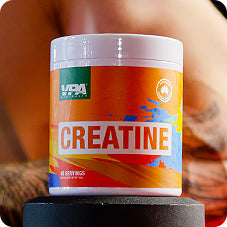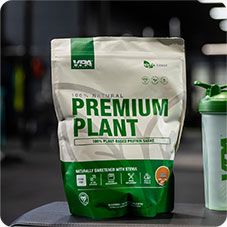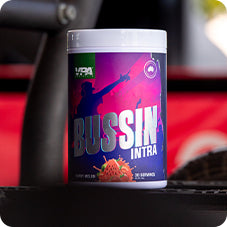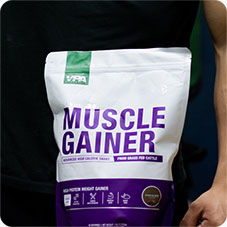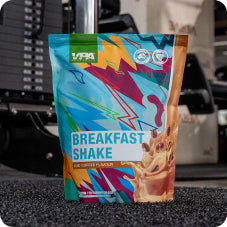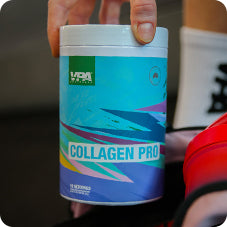- $0.00 AUD Subtotal
Do You Need to Cycle Creatine for Optimal Muscle Growth?
August 10, 2018 8 min read

Creatine is one of the most useful, effective, yet cheapest supplements on the market. There are many reasons why creatine should be an essential part of your daily supplement stack. However, if you need a refresher you can check out this blog.
Creatine has become a staple in many fitness enthusiasts’ supplement regimens, but a few myths about creatine continue to surface. One of these is that creatine needs to be cycled to be safe and effective. Let's break down what creatine is, address common myths, and discuss how to implement a creatine cycle for beginners.
What is Creatine and what does it do?
Creatine is a natural source of energy that helps your skeletal muscles contract. It is crucial in producing energy in your muscles, especially during high-intensity exercise. Your body produces creatine naturally but supplementation can increase the body’s phosphocreatine stores, which improves performance in activities like weightlifting or sprinting.
Protein-rich foods like milk, red meat, seafood, and more also lead to more creatine supply for your body, ultimately improving muscle growth and enhancing recovery.
Myth-Busting: Common Misconceptions About Creatine
Despite its various benefits, several myths have been surrounding the use and safety of creatine. Let’s debunk some of the most common misconceptions:
Myth 1: Creatine is hard on the kidneys and liver.
There are no negative side effects of creatine use on your liver or kidneys. The scientific literature is full of studies showing creatine to be safe for both short-term and long-term use.
However, taking creatine might worsen kidney or liver disease in people who have already been diagnosed with such conditions. Therefore, those with pre-existing kidney or liver issues should consult with a healthcare professional before using creatine.
Myth 2: You need to cycle so you don’t build a tolerance to it.
Your body doesn’t build up a tolerance to creatine. It is possible that you may no longer consciously register the boost it provides, but this is simply because you are now operating optimally at each session. Just because you don’t notice the impact of creatine supplementation doesn’t mean you aren’t benefiting. Any plateaus to hypertrophy or strength can more than likely be put down to training or a sad farewell to newbie gains.
Myth 3: Cycling off creatine keeps your body’s natural production high
There are no scientific studies that suggest your body will stop producing creatine when an external creatine source is supplied for long periods of time. The system that uses creatine in your body is very adaptable and will take any creatine it can when required for explosive movement.
Why Cycle Creatine?
So, if cycling isn't required for the safe and effective use of creatine, why do some people choose to cycle creatine? Some athletes prefer to reset their supplement regimen and give their bodies a break from long-term supplementation.
Implementing a Creatine Cycle: How to Do It?
If you finally decide to cycle creatine, here’s how to go about it.
Overview of a Creatine Cycle
When people talk about a creatine cycle they are referring to a three-phase cycle. First, there is a high-dose creatine loading phase, followed by a lower-dose maintenance phase, and finally a period of taking no creatine at all
The Loading Phase
Creatine loading is the first phase of the creatine cycle. It refers to a short period of time where you take a high dose of creatine to achieve maximum creatine storage in your muscles as quickly as possible.
A standard creatine loading stage recommends that 0.3g of creatine per kilogram of body weight is consumed each day for 5-7 days. For example, if you weigh 70kg, this would be calculated as follows: 0.3 x 70 = 21g per day.
This load phase daily dose is usually split over 3 or 4 doses in a day. This helps ensure that no digestive discomfort is experienced during the creatine loading phase.
The Maintenance Phase
After the creatine loading period is completed, we move on to the maintenance phase.
A standard maintenance phase recommends that 0.03g of creatine per kilogram of body weight is consumed every day. For example, if you weigh 70kg, this would be calculated as follows: 0.03 x 70 = 2.1g per day.
As daily supplementation does not cause side effects or negatively impact health (if one does not have any pre-existing health conditions), many people choose to round this up to a flat 5g of creatine per day. This can be taken at any time, as long as it is taken every day.
The Time-off phase
The time-off phase lasts for 2-4 weeks and during this time, you stop taking supplements and give your body a break. This phase is optional, but people cycling creatine typically take a break to prevent bloating or gastrointestinal discomfort that may be caused by the creatine loading phase.
Benefits of Creatine Cycling
While creatine cycling is not essential, it is reported to have some benefits, including:
-
Enhanced muscle strength and endurance: Usage of creatine supplements helps with building muscle and endurance. This results in improved performance during explosive activities.
-
Muscle recovery: Creatine has been shown to improve muscle recovery after high-intensity exercise, reducing muscle soreness and allowing you to get back to your workouts quickly.
-
Psychological reset from supplements: Some people might just want to take a break from taking extra supplements and give their body a reset.
Potential Risks and Safety Considerations of Creatine Cycling
Creatine is generally safe for most people when taken at the recommended daily dose. Although side effects are rare, it’s important to know about them.
Side effects
Creatine might alter your body’s stored water content, driving additional water to your muscle cells. Some people might experience dehydration as a result. However, the shift in cellular water content is very minor and will very rarely lead to dehydration.
Who should avoid Creatine?
Creatine can slightly raise creatinine levels in the blood, which is commonly measured to diagnose kidney or liver conditions. But that doesn't mean creatine supplements can harm your liver or kidneys.
However, People with pre-existing liver or kidney concerns should consult a healthcare professional before taking creatine supplements.
Pregnant or breastfeeding women should also seek medical advice before using any supplementation.
Creatine for Different Types of Athletes
Athletes from various sports can benefit from using creatine supplements. However, the benefits and dosage of creatine may vary according to the type of sport undertaken:
Strength Athletes vs. Endurance Athletes
For strength activities like powerlifting and weightlifting, the recommended dosage of creatine is higher due to the explosive nature of such activities. The best creatine for muscle growth in these sports is creatine monohydrate, which is proven to be highly effective in increasing muscle strength and size.
For endurance athletes, although quick bursts of energy are not required, creatine can store energy in the muscles, improving overall performance.
Creatine in Team Sports
Team sports like football, volleyball, cricket, and many other sports require both strength and high-intensity activity and creatine supplements are beneficial to maintain energy levels.
Optimising Creatine Use
To maximise the benefits of creatine supplementation, following a few best creatine cycle practices can help ensure you're getting the most out of it.
Best Practices for Creatine Intake
-
Stay consistent: Take your creatine dose daily, whether it's a training day or a rest day. This ensures your muscles maintain saturation and that the benefits remain steady over time. Missing doses may diminish the effectiveness of the supplement.
-
Timing: The next question is “When to take creatine?”. While creatine timing isn't critical, many athletes prefer to take it post-workout. Some research suggests taking it both- before and after a workout can be advantageous.
-
Loading phase for faster results: If you're new to creatine, you might consider starting with a loading phase. This rapidly saturates your muscles and allows you to experience the benefits more quickly. After the creatine loading period, a maintenance phase with a low-level dosage can follow.
-
Stay hydrated: Since creatine draws water into your muscles, it’s important to stay properly hydrated while supplementing. Aim to drink more water than usual, especially during high-intensity workouts, to prevent dehydration.
Diet and Creatine
It's important to remember that creatine is just a supplement, not a substitute for a balanced and nutritious diet. Creatine works best alongside a diet that includes adequate protein, carbs, and fats to fuel your workouts and recovery. While supplements can help with muscle strength and recovery, natural sources of creatine like red meat, fish, and other seafood must also be a part of your regular diet.
Maximise Your Gains with VPA’s Creatine Monohydrate
So there you have it. Everything you need to know about creatine cycling and why it is unnecessary. The key points about supplementing with creatine are that it should be taken every day to keep your muscle stores up, regardless of whether you are training or not. If you’re looking for a top-tier creatine supplement, VPA’s Creatine Monohydrate is a trusted option. With 100% purity and athlete-approved, you can be confident that you're giving your body the best support for muscle growth and performance.
Check out VPA’s Australian-made creatine monohydrate powder online here, crafted locally for top quality and performance.
FAQs About Creatine Cycling
How long should you cycle creatine?
A typical creatine cycle lasts about 6-8 weeks. It starts with a loading phase of 5-7 days, followed by a maintenance phase for several weeks, and then an optional time-off phase of 2-4 weeks to give your body a break.
Should you take breaks from creatine, or can it be used continuously?
While creatine can be used continuously without causing harm, some people prefer to take breaks during a time-off phase (2-4 weeks) to avoid potential bloating or gastrointestinal discomfort. However, breaks aren't necessary for everyone, and long-term use is generally safe.
What does a 7-day loading phase for creatine involve?
A 7-day creatine loading phase involves taking a high dose of creatine to quickly saturate your muscles. Typically, you’ll consume 0.3g of creatine per kilogram of body weight each day, split into 3-4 doses.
What happens if you don't cycle creatine?
You’ll continue to benefit from its effects. Creatine can be taken continuously without the need for breaks, as long-term use has been shown to be safe. Cycling is optional and typically done to avoid minor side effects
What are the benefits of cycling creatine versus continuous use?
Creatine cycle offers benefits like reducing the risk of potential side effects, such as bloating, dehydration, or gastrointestinal discomfort, that may arise during the loading phase.
Can cycling creatine improve its effectiveness?
Not really! Once your muscles are saturated with creatine, continuous use maintains those levels. Therefore, it’s better to stay consistent. But if you’re experiencing any side effects, you might opt for a creatine cycle.
How does creatine affect hydration and kidney function?
Creatine can affect hydration by drawing water into your muscle cells, which may increase your need for fluids to stay properly hydrated. As for kidney function, creatine is generally safe if consumed in recommended dosages. However, if you have pre-existing kidney issues, it’s best to consult a doctor before using creatine supplements.
References

Also in Supplements

Stamina vs Endurance: Understanding the Key Differences and How to Improve Both
March 13, 2025 7 min read
Read More Recent Articles
- Collagen Protein vs Whey Protein: Which One Should You Choose?
- Stamina vs Endurance: Understanding the Key Differences and How to Improve Both
- BCAA vs Creatine: Which Supplement is Right for You?
- Best Supplements for Muscle Gain: What Really Works?
- What to Look for in a Pre-Workout: Key Ingredients Explained
- How Is Protein Powder Made? A Comprehensive Guide
- Creatine Before or After Workout: When Is Best?
- How Long Does Pre-Workout Last? Find Out to Maximise Your Sessions
- Whey Protein for Weight Loss: How It Helps and Best Practices
- Best Protein Powders in Australia and How to Choose the Right One for You


